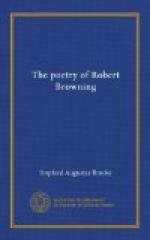chosen, and harmonised with the expression of the
face. Painting dedicated its work to the representation
of the heavenly life, either on earth in the story
of the gospels and in the lives of the saints, or in
its glory in the circles of heaven. Then, too,
it represented the thought, philosophy, and knowledge
of its own time and of the past in symbolic series
of quiet figures, in symbolic pictures of the struggle
of good with evil, of the Church with the world, of
the virtues with their opposites. Naturally,
then, the expression on the face of secular passions,
the movement of figures in war and trade and social
life and the whole vast field of human life in the
ordinary world, were neglected as unworthy of representation;
and the free, full life of the body, its beauty, power
and charm, the objects which pleased its senses, the
frank representation of its movement under the influence
of the natural as contrasted with the spiritual passions,
were looked upon with religious dismay. Such,
but less in sculpture than in painting, was the art
of the Renaissance in its childhood and youth, and
Browning has scarcely touched that time. He had
no sympathy with a neglect of the body, a contempt
of the senses or of the beauty they perceived.
He claimed the physical as well as the intellectual
and spiritual life of man as by origin and of right
divine. When, then, in harmony with a great change
in social and literary life, the art of the Renaissance
began to turn, in its early manhood, from the representation
of the soul to the representation of the body in natural
movement and beauty; from the representation of saints,
angels and virtues to the representation of actual
men and women in the streets and rooms of Florence;
from symbolism to reality—Browning thought,
“This suits me; this is what I love; I will
put this mighty change into a poem.” And
he wrote
Fra Lippo Lippi.
As long as this vivid representation of actual human
life lasted, the art of the Renaissance was active,
original, and interesting; and as it moved on, developing
into higher and finer forms, and producing continually
new varieties in its development, it reached its strong
and eager manhood. In its art then, as well as
in other matters, the Renaissance completed its new
and clear theory of life; it remade the grounds of
life, of its action and passion; and it reconstituted
its aims. Browning loved this summer time of
the Renaissance, which began with the midst of the
fifteenth century. But he loved its beginnings
even more than its fulness. That was characteristic.
I have said that even when he was eighty years old,
his keenest sympathies were with spring rather than
summer, with those times of vital change when fresh
excitements disturbed the world, when its eyes were
smiling with hope, and its feet eager with the joy
of pursuit. He rejoiced to analyse and embody
a period which was shaking off the past, living intensely
in the present, and prophesying the future. It




